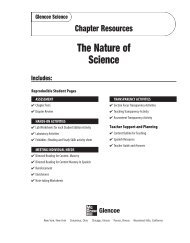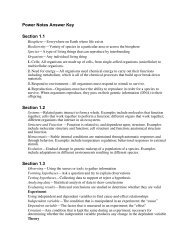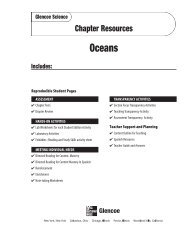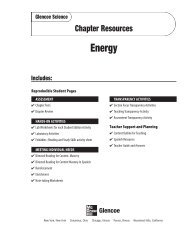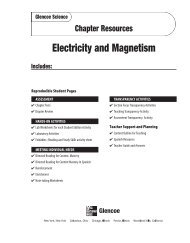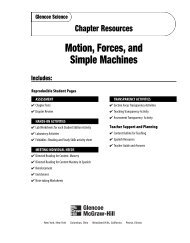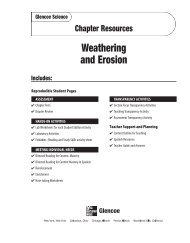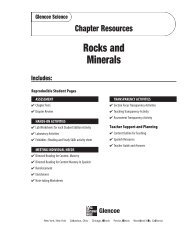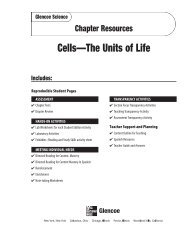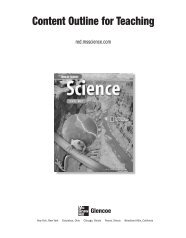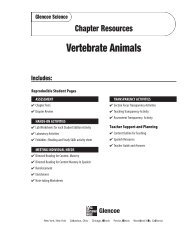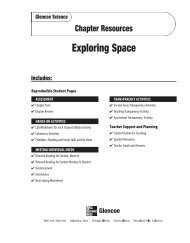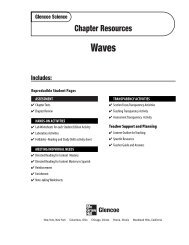Chapter 21 Resource: Ecology
Chapter 21 Resource: Ecology
Chapter 21 Resource: Ecology
- No tags were found...
Create successful ePaper yourself
Turn your PDF publications into a flip-book with our unique Google optimized e-Paper software.
Copyright © Glencoe/McGraw-Hill, a division of the McGraw-Hill Companies, Inc.Teacher Guide & Answers (continued)■ There are over 1000 species of sea anemonesthroughout the world, however only 10 speciescarry on symbiotic relationships with clown fish.■ Clown fish spend most of their time among thestinging tentacles of the anemones. When theclown fish first decides to inhabit an anemone, itdemonstrates behavior consistent with that ofbeing stung. Scientists have recently discoveredthat the previous theory of the clown fish’s immunityto anemone venom is not entirely true. Inactuality, the clown fish has developed a system inwhich it carefully rubs itself against the anemone’smucus-clad tentacles, coating its own body in themucus, which provides immunity.■ Sea anemones are also part of a symbiotic relationshipwith hermit crabs. These anemones havea special somersault behavior, which allows themto climb on gastropod shells. Some hermit crabscan get a sea anemone to climb on its shell byrubbing the sea anemone in a certain way. Hermitcrabs move to a new shell when they outgrowtheir current shell; those living with sea anemonesmove the anemone to their new shell. Some crabsthat do not live in shells also live with seaanemones. The crabs put sea anemones on theircarapace and legs. Sea anemones protect crabsand hermit crabs from predators such as octopusesor even other crabs. This relationship isknown as commensalisms—a relationship inwhich one organism benefits (the hermit crab)and the other is unaffected (the anemone).Answers to Student Worksheet1. Possible answers: The clown fish gets protectionfrom its predators. The tentacles keep the fish’spredators from attacking it.2. Possible answers: The anemone gets protectionfrom its predators; the clown fish may drop piecesof food as it is eating, and the anemone would eatthe food; the clown fish pick parasites off of theanemone.3. Possible answers: They have adapted to eat othertypes of food.Section Focus Transparency 3 (page 42)What’s For Dinner?Transparency Teaching Tips■ Use this transparency to introduce the concept ofproducers, consumers, and decomposers. Pointout that energy is transferred through feedinginteractions. Compare the feeding interactions ofthe rabbit, human, and fungus.■ Students may not recognize the fungus breakingdown the wood as a feeding interaction. Describethe process to students. Ask what will happen overtime to the wood. (It will break down further andits matter will be used by other organisms.) Ask:What if there were no organisms like the fungusto break down dead organisms? (Organisms couldnot recycle matter. The Earth would be coveredwith dead organisms.)■ Show students a piece of rotting fruit. Allow themto examine the softened tissues of the rotted partof the fruit. Point out that this is caused by thefungus secreting digestive enzymes. Parts of thefruit are being taken into the fungus as nutrition.■ With students’ direction, draw a food chain on theboard using the lettuce, fungus, rabbit, and ahuman. Then ask students what would happen ifany one of the organisms was missing from thefood chain.Content Background■ Green plants carry out photosynthesis. They trapenergy from sunlight and convert it to carbohydrates.When animals eat plants, they release theenergy and use it to carry out life processes. Inthis way, energy from the Sun is transferred fromorganism to organism.■ Unlike animals, fungi do not ingest food and thenabsorb nutrients from the food within their ownbodies. Instead, fungi break down food into nutrientsoutside their body. They do this by secretingdigestive enzymes onto the material they want tobreak down. Then they absorb the digestednutrients.Answers to Student Worksheet1. Possible answers: by eating and digesting food.2. Possible answers: All three forms of nutrition arerecycling matter.3. the SunTeaching Transparency (page 43)Food ChainSection 2Transparency Teaching Tips■ Discuss the relationship between the levels of thefood chain pictured in the transparency.■ Have students offer other animals that could besubstituted for each level—for instance, pondalgae for the field grasses or a crow for thesparrow.Reteaching Suggestion■ Change the habitat to a water-based one byreplacing the grasses with seaweed. Have studentsdo some research and suggest organisms thatwould fit into a food chain or food web in thewater habitat.Teacher Support & Planning<strong>Ecology</strong>T13




